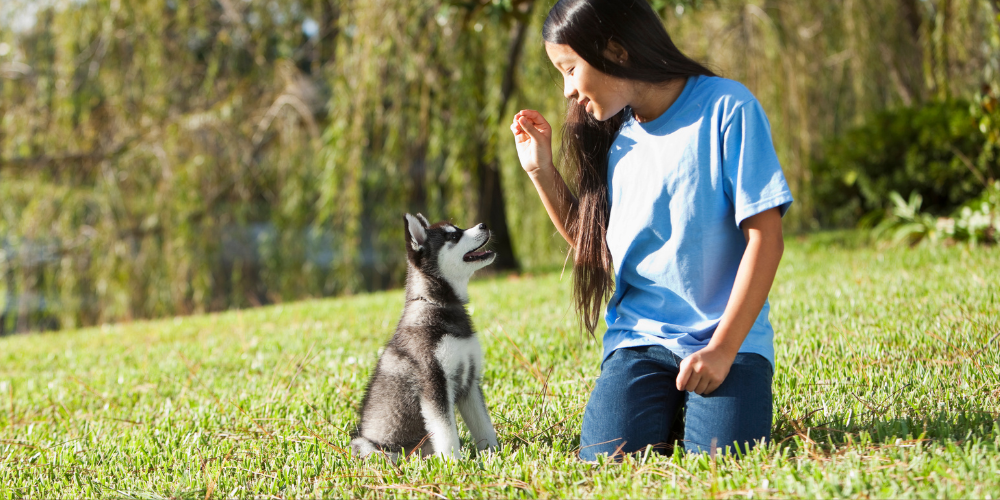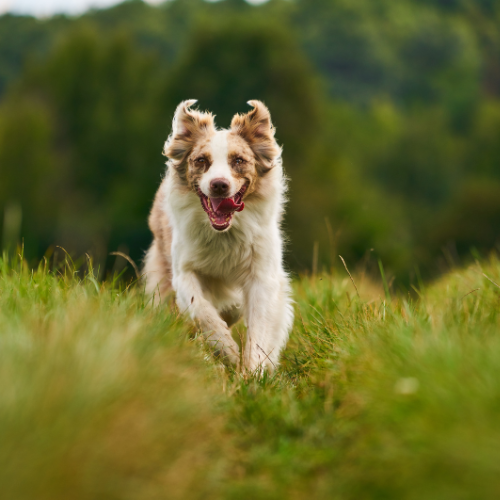June 29, 2023
What is positive reinforcement dog training?
Positive reinforcement (R+) is a type of dog training that uses rewards to increase the likelihood of a behavior happening again.
R+ is one quadrant of operant conditioning (the others are R-, P+ and P-). Operant conditioning is a method of learning where behavior is modified by adding or taking away good or bad things. Good things being food treats, praise and play. Bad things being leash jerks, shock, choking, etc.
Positive reinforcement means something good is added (a reward is given after a behavior) and the frequency of that behavior increases in the future.
As Zazie Todd puts it, “…you ask the dog to sit, the dog sits, and you give him a treat (something is added). The dog is more likely to sit next time you ask (the behaviour was reinforced)(Todd).”

Types of rewards
Rewards are things your dog already loves, such as treats, praise and play. Rewards are given after a behavior occurs. It tells the dogs “yes! I want more of that!”
Most dogs are motivated by food, and that’s why trainers most commonly use food as rewards. You might see trainers with various types of food rewards in their training pouches. You might see chicken, cheese, hot dogs, cheerios, crunchy cookies, or stinky sardines. Food rewards are organized in categories based on their value, or how valuable they are in a dog’s eyes.

Value levels
Low: kibble, cheerios, Milk-Bone
Medium: chicken, cheese stick, freeze dried liver
High: sardines, cat or wet food, hot dogs
How to choose reward values
Trainers choose food rewards based on a few factors including, what type of behavior is being trained, what the current environment is and what motivation the dog currently has.

Some dogs are more food motivated than others. Some dogs may work for Cheerios or kibble while some may require chicken or something higher in value. Figuring out what rewards your dog will work for and under what conditions is something all dog owners should know.
For example:
My dog will do basic skills in our house for kibble. When we go out on a walk I need to reward her with chicken or a higher value treat like Ziwi Peak. Therefore, I upgrade treats when we’re outside because there are lots of competing and more interesting factors in the environment.
There are smells, birds, squirrels, people, other dogs, sounds, and tons of pee mail. I wouldn’t expect my dog to ignore all of those things to give me a behavior like sit just for some kibble.
Reward behaviors appropriately so that your dog is more likely to repeat them in the future. Behavior isn’t free and won’t magically occur without reinforcement.
Other types of rewards
Another type of positive reinforcement in dog training is play, or life rewards.
For example, if your dog loves playing tug you can give your dog a 15 second tug game for completing a behavior. Or you can throw a ball for a chase game or open the backdoor for a romp in the yard.
And praise is the last type of reward. Use it in conjunction with food and play. Only use praise on it’s own when: the behavior is strong, you’re rewarding intermittently, or if you don’t have food or life rewards handy.
You can do a test with your dog and build your own reward value scale. Try out a few different rewards and see which one’s your dog likes best! Then use those for training or mix them in with some lower value rewards.
Positive reinforcement is not bribery
Renowned dog trainer, Victoria Stilwell, busted the myth that rewards are bribery.
She wrote that it,
“suggests a fundamental lack of understanding regarding the basic scientific principles of how reward-based training (conditioning) works” (Stilwell)
Scientifically, reward-based training uses the principles of operant conditioning. Boiled down it flows like this:
Antecedent (A) —> Behavior (B) —> Consequence (C)
A = Ask a dog to sit
B = Dog sits
C = Dog receives reward
If the frequency of the behavior increases then you have positive reinforcement, or reward-based training. In this flow, the behavior always occurs before the reward.
Bribery is the opposite of reward-based training. With bribery, the reward comes first in order to entice the behavior you want. Sometimes this is a useful tactic in dire situations.
For example, your dog has a dangerous item in their mouth and “drop it” isn’t working. In this situation you might toss a bagful of cheese on the ground so that your dog lets go of the item in order to eat the cheese. I believe this order of events is okay in emergency situations.
What is a positive reinforcement trainer?
Trainers that call themselves R+, force-free, fear-free or positive reinforcement dog trainers will stick to using rewards to build and strengthen behaviors. They will never utilize force, harm, dominance, pain, fear or any other inhumane tactic to get a behavior or to punish a behavior.
If you are searching for a trainer and they use electronic collars, “training” collars, pinch, choke or prong collars, shake cans, sprays, leash jerks, or physical corrections of any kind, run far, far away! Not only are these “tools” inhumane, but it’s been studied that these techniques can cause major damage to the mental and physical state of a dog.
One such study found that R+ training addressed target behaviors better than training with an E-collar, and that R+ training posed “fewer risks to dog welfare and quality of the human-dog relationship (Cooper et al 2014).”
Positive reinforcement dog training has the science to back it up, is more fun (unless you’re a masochist), and is proven to build stronger bonds between dog and trainer.

How to find a Positive Reinforcement Trainer
Dog training is an unregulated industry, therefore anyone can create a website, call themselves a trainer and take your money. However, there are some reputable educational institutions, associations and certifications to look for.
Education
Associations
The Pet Professional Guild (PPG)
Certifications
Certificate in Training and Counseling (CTC)
Certified Separation Anxiety Trainer (CSAT)
Certified Professional Dog Trainer-Knowledge Assessed (CPDT-KA)
Check out my positive reinforcement dog training services
If you are planning on adopting a dog check out my Puppy Prep Zoom, which is a virtual session where you can ask me, a professional dog trainer, any questions.
We’ll chat about how to puppy-proof your home, socialization, and potty training.
You can also check out my Puppy Socialization Program, which focuses on safe socialization.
The socialization period is time sensitive and very important.
My last program is the Wildflower Puppy Program, which focuses on obedience training and manners.
We also set up routines and establish a solid foundation of good behavior that you can build on.
Want some more free educational information? Check out my other blog posts, or follow me on Instagram (@wildflowerdogtraining_)
About Me
I’m Lauren, a positive reinforcement dog trainer in Denver, Colorado with Wildflower Dog Training.
I earned my Certificate in Training and Counseling (CTC) from The Academy for Dog Trainers in 2022.
I use positive reinforcement and force-free training.
All of my training is based on the science behind animal learning and behavior.

Resources
Cooper, J. J., Cracknell, N., Hardiman, J., Wright, H., & Mills, D. (2014). Efficacy of Dog Training With and Without Remote Electronic Collars vs. a Focus on Positive Reinforcement
. PloS one, 9(9), e102722.
Todd, Zazie. (2017). What is Positive Reinforcement in Dog Training?
Leave a Reply Cancel reply
popular blog posts
Lauren Zimniski of
Wildflower Dog Training offers
dog & puppy training in Denver, CO
view our service area
Lauren@wildflowerdogs.com





post comments